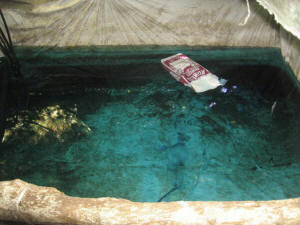|
Banned pesticides from illegal pot farms
seep into California water
 Send a link to a friend
Send a link to a friend
 [September 08, 2017]
By Sharon Bernstein [September 08, 2017]
By Sharon Bernstein
SACRAMENTO, California (Reuters) - Toxic
chemicals from illegal marijuana farms hidden deep in California's
forests are showing up in rivers and streams that feed the state's water
supply, prompting fears that humans and animals may be at risk, data
reviewed by Reuters show.
The presence of potentially deadly pollutants in eight Northern and
Central California watersheds is the latest sign of damage to the
environment from thousands of illegal cannabis plantations, many of them
run by drug cartels serving customers in other states, according to law
enforcement.
"I don't drink out of the creeks - and I used to," said Sergeant
Nathaniel Trujillo, a narcotics expert with the sheriff's department of
Trinity County, about 200 miles north of San Francisco. "I grew up
drinking out of them."
California accounts for more than 90 percent of illegal U.S. marijuana
farming. There are as many as 50,000 marijuana farms in California
according to state estimates, and even though voters legalized the drug
last November, only about 16,000 growers are expected to seek licenses
when commercial cultivation becomes legal next year.
Many of the illegal growers use fertilizers and pesticides long
restricted or banned in the United States, including carbofuran and zinc
phosphide.

The chemicals have turned thousands of acres of forest into waste dumps
so toxic that law enforcement officers have been hospitalized after
inadvertently touching plants and equipment, and scores of animals have
died.
The streams in which they have been detected are crucial sources of
water for fish, vulnerable animals including the Pacific fisher and the
Northern Spotted Owl and are used for drinking by people and cattle.
Ultimately, the contaminated rivers and creeks flow into the massive
water supply system relied on by the most populous U.S. state.
"Carbofuran is in the water, and it's not supposed to be," said Mourad
Gabriel, an ecologist who works with law enforcement on marijuana
contamination issues. "How are we going to mitigate something like
that?"
Carbofuran poisoning can cause headaches, nausea, dizziness, vomiting,
uncontrollable muscle twitching, convulsions and even death, according
to the National Institutes of Health.
Poisoning by diazinon, another chemical Gabriel has found in streams,
can cause difficulty breathing, weakness, blue lips and fingernails,
convulsion and coma, the agency says.
Gabriel, who has visited more than 100 sites in California and is widely
considered the leading authority on toxins at marijuana farms, said
about half the streams he studied in eight watersheds in the state's
prime pot-growing regions tested positive for contaminants.

In unpublished data seen by Reuters, Gabriel's testing showed
carbofuran, diazinon and other chemicals were present downstream from
pot farms in Kern County in Central California, Humboldt County on the
state's northwestern coast, Mendocino County north of Santa Rosa and
others. In some cases, the chemicals were present only in trace amounts.
Some streams tested positive more than a year after law enforcement
cleared illegal grows from nearby land.
At Brush Mountain in Kern County, law enforcement shut down a growing
operation in June 2014, Gabriel said. But testing the following November
and December showed the presence of diazinon in a local stream.
CHEMICAL 'LAYER CAKE'
In further testing in February 2015, the stream appeared to be
chemical-free. But chemicals showed up again the following year,
Gabriel's unpublished data show, prompting him to speculate that it can
take months or years for chemicals to migrate through the soil.
[to top of second column] |

Blue-tinted water with fertilizer at an illegal marijuana growing
site in Mendocino County, California, U.S. is pictured in this
undated handout photo obtained by Reuters on July 25, 2017. Coutesy
California Department of Fish and Wildlife/Handout via REUTERS

"It's like a layer cake," Gabriel said. "They put chemical on
chemical on chemical. We'll find different chemicals in the water on
different years."
In another instance, a stream in Trinity County tested negative for
pesticides in 2014 but positive in December 2016.
The state does not have a comprehensive testing program for
marijuana contaminants, and little such work has been done at the
local level, officials said.
But many people and animals rely on water from local streams. And
some are growing concerned.
Patricia Young, whose family grazes cattle in Shasta County, said
eight cows have died suddenly over the past three years near an
irrigation channel they use for drinking.
Young said the family was worried the cows died from poisoning from
marijuana farms in nearby woods, and they were testing the stream.
The chemicals have been found in game animals, including a quail
Gabriel shot and ate with his family, and numerous deer and elk
whose livers were tested in a study for the Mule Deer and Rocky
Mountain Elk Foundations, he said.
Trujillo, the Trinity County sheriff's department narcotics
sergeant, said his law enforcement dog, a Belgian Malinois named
Johnny, almost died from pesticide poisoning after jumping into a
reservoir at an illegal marijuana grow.

California is developing regulations for marijuana farms including
rules about water quality and pesticide use, but widespread water
testing is not included.
The federal government, which owns much of the land on which illegal
marijuana grows are planted, has also not conducted extensive
testing of streams near the toxic sites, officials said.
Matt St. John, executive officer of the North Coast Regional Water
Quality Control Board in the heart of marijuana country, said his
agency is planning to regulate pesticide use by marijuana farmers.
But testing streams on a regular basis would be too expensive, he
said.
Trinity County supervisors will decide on Sept. 19 whether to
authorize a testing program along part of the Trinity River and its
tributaries.
"Maybe six months down the road we'll say water quality wasn't
affected all that much," said Trinity County Planning Director
Leslie Hubbard. "But maybe we'll say we have a disaster on our
hands."
(Reporting by Sharon Bernstein; Editing by Ben Klayman and Cynthia
Osterman)
[© 2017 Thomson Reuters. All rights
reserved.]
Copyright 2017 Reuters. All rights reserved. This material may not be published,
broadcast, rewritten or redistributed.

 |